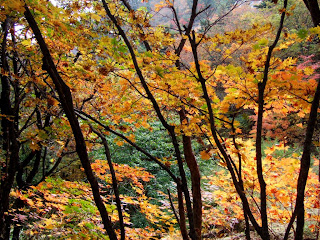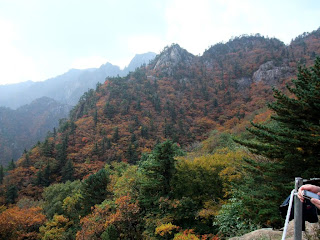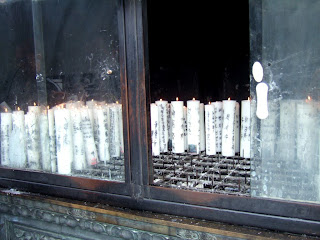


Seoraksan located at the Seorak National Park near the city of Sokcho, is considered as the highest mountain of Taebaek Ranges, the back bone of Korea Peninsula. It is a renowned habitat for rare plants and animals. There are more than 1500 kinds of insects and animals like black bear, musk deer and thousand over plants species within mountains and valleys. It was designated by UNESCO in 1992 as a biosphere reserved region.


Mt Seorak is the third highest mountain in the country with 1708 meter high peak at Daecheongbong. It has 28 peaks with 58 valleys, 9 hills, 2 hot springs, 15 granite rocks formations, 12 Buddhist temples and hermitages.


Seoraksan and National Park roughly divided into three main areas. Oeseorak (Outer part) has steep slopes closer to the sea and less flora and fauna. Naeseorak(Inner part) is farthest inland section with smooth slopes and ideal for lush growth of plants and other living things. Together with Namseorak (Southern part), it covers a total area of about 354 sq km.


The area boasts for its beauty in spring blossoms and fall foliage.


Autumn colors in Seorak National Park is considered the most beautiful in Korea.


A Kaleidoscope of brilliant colors.


Various forms and colors offered by nature are fully displayed at Inner Seoraksan.




It has multi hiking courses and many cultural artifacts hidden in each valley.







Seoraksan is a luxurious forest occupying mix deciduous broad leaves trees and alpine coniferous plants at high elevations near the ridges.


Pine trees are usually at southern slopes while oak and other deciduous trees are at northern slopes.






Red and yellow forest interrupted by rocks and sometimes with small mountain streams following amidst, appeared exactly like piece of painting art.










Nature changes the foliage to various shades of red, yellow and gold color.


Fabulous views of the mountains and valleys.




Craggy mountains wreathed in the mist. The peaks rears up from coastal plain instead of from foothill. The granite and gneiss topped peaks occurred into fantastic formations resembling battlements and towers of a fortress, appear like an old ink painting.


Hiking up the 888 steps of wooden stairs is the way to Ulsanbawi. While hiking into valley is the famous site of Baekdamsa, another cultural property of Seoraksan. It was built by the same reverent of Sinheungsa during the same period in 647AD. The monk from Baekdamsa was reciting blessing chant at the cross road for all visitors while nuns were visitors from overseas.


The Heundeulbawi also known as Tottering Rock just near Gyejoam peak, is actually a large round boulder sitting precariously on a big stone at the cliff as if roll off anytime or at a slightest touch. Though groups of people tried to push it over, it remains at its position years after years without an inch moved.


Ulsanbawi is actually a spectacular outcropping of granite, quartz and mica risen to an altitude of 873 meter with circle circumference of 4 km. The legend said that this rock was from a southern city of Ulsan and was carried to Mt Geumgangsan by a God who dropped it here after hearing that Mt Geumgangsan already had 12000 mountain peaks.


This huge hunk of rock is situated on top of Gyejoam mountain, accessible through several trails and there is a natural cave with beautiful waterfall.


There are altogether six granite peaks and ruffed cliffs offering memorably scenery. The Ah-Choo-Ma, the Korean elderly aged women are the regular hikers. They are tough, friendly and supporting.



There are numerous trails of various length, ranging from several hours to days leading through inner Seoraksan to outer Seoraksan.


There is a small Buddhist temple at the low valley of the mountain. With the help of ropes, we made our descend to the temple through the long stone stairway to pay a sincere respect to the Buddha images within a short limited time from our scheduled booking time of cable car.



Breath-taking scenery upon arrival of the hill station.


Some mountain views from cable car.


The cable car service is based on time schedule booked and it only is able to take less than 50 persons per cabin.




The cable car station and the granite features upwelling to 1000 to 1500 meters.


Looking up is the unique rocky formations while looking down, Seorak Tourist Resort and Hotel complex is nested in the valley of the mountains.




Bird eye's view of Sinheungsa and the bronze seated Buddha.



This is the most scenic site of outer Seoraksan with waterfalls and cultural property of Sinheungsa and its Gyejoam hermitage.





The largest bronze sitting Buddha Image in Korea, who offers a boundless blessing for both North and South Korean. Many of them come here and request for peace.


Signed up a piece of roof tiles, lighted up a candle or an offer of meal are an wholesome deed for most Buddhist devotees. There is a counter preparing all these with your names at a cost of between US$10 to 30 each.



The entrance of SinHeung Temple is always the beginning point of hiking up the mountains to Gyejoam.


SinHeungsa is the oldest Seon (Zen) Temple in Korea. The small historical temple was originally built by a revered monk of Silla Kingdom in the year 653.


There are 280 Buddhist Sutra wood printing blocks at Singheung Temple. The blocks were used to print Buddhist Scriptures and these blocks contains Chinese originals and a Korean translation


SinHeung Temple emphasizes on Mahayan Pureland tradition, offers Amitabha and Avalokitesvara, the Goddess of Mercy at this quiet and beautiful environment. Meditation practices are carried out in this Hall.


The central building of Eternal Happiness Hall, Kukrakbojeon, built in 1647 , houses images of eternal and immeasurable Buddha Amitabha and Bodhisattva of western paradise. The 190 sq meter timber framed building was repaired in 1750 and 1821 but keep to its original architectural style of late Chosun period.



Kukrakbojeon, The Eternal Happiness Hall was fully framed by timber while Bojeru Temple constructed in 1770, was made up of two layers big long stones as foundation.


Temple complex surrounded by dense forest inside the valley of scenic Seoraksan.



Main entrance of Seorak National Park.


Koreans are the toughest mountain hikers. Groups of elderly aged women in bright color attire and hat is part of the scenery at this beautiful Seorak National Park.


The interesting water tap, like magic, supply out water without any connection.



Local delicacy, fired crickets, steam and grilled sweetcorn, home-made healthy drinks sold at simple stores at the park.




Fresh wild ginseng, local mountain grown herbs and local ginkgo, displayed on the ground for sales.



We had a healthy and tasty vegetarian wild mushroom meal at this cosy wooden restaurant. The home made cabbage kimchi was the best among all.


The main road that connects the resort to Seorak National Park.


There are two huge stone grandfathers on each side of the road leading to mountain trail, protecting safety of hikers, as what Koreans believe.


Many locals started their mountain hike early in the morning from this destination right inside the resort.



Scenic view of the surrounding areas from Resort Garden.


The car park looks like just sit at the foot of this rocky mountain of Taebaek ranges.


Green Apple? I was not sure, but many trees are planted along the road towards the mountain.






Vegetation along the lanes of hotel compound.



Spectacular view of mountain ranges from the hotel where we stayed.


Daemyung Resort Hotel located at the actual park at the foot of Seoraksan.

